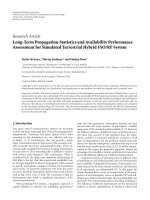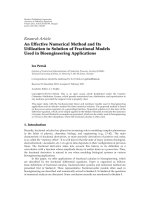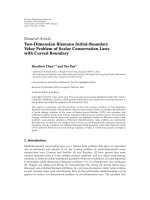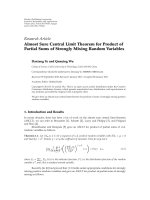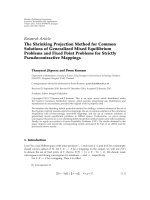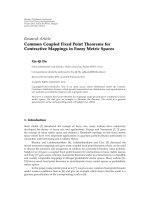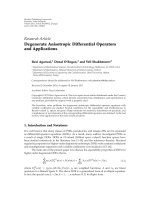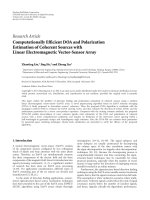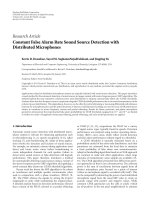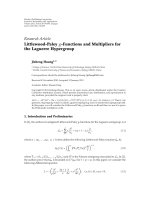báo cáo hóa học:" Research Article Relation between Fixed Point and Asymptotical Center of Nonexpansive Maps" doc
Bạn đang xem bản rút gọn của tài liệu. Xem và tải ngay bản đầy đủ của tài liệu tại đây (464.8 KB, 6 trang )
Hindawi Publishing Corporation
Fixed Point Theory and Applications
Volume 2011, Article ID 175989, 6 pages
doi:10.1155/2011/175989
Research Article
Relation between Fixed Point and Asymptotical
Center of Nonexpansive Maps
Mohammad Reza Haddadi, Hamid Mazaheri,
and Mohammad Hussein Labbaf Ghasemi
Department of Mathematics, Faculty of Mathematics, Yazd University, P. O. Box 89195-741, Yazd, Iran
Correspondence should be addressed to Mohammad Reza Haddadi,
Received 19 October 2010; Accepted 22 November 2010
Academic Editor: Qamrul Hasan Ansari
Copyright q 2011 Mohammad Reza Haddadi et al. This is an open access article distributed under
the Creative Commons Attribution License, which permits unrestricted use, distribution, and
reproduction in any medium, provided the original work is properly cited.
We introduce the concept of asymptotic center of maps and consider relation between asymptotic
center and fixed point of nonexpansive maps in a Banach space.
1. Introduction
Many topics and techniques regarding asymptotic centers and asymptotic radius were
studied by Edelstein 1, Bose and Laskar 2, Downing and Kirk 3, Goebel and Kirk 4,
and Lan and Webb 5. Now, We recall that definitions of asymptotic center and asymptotic
radius.
Let C be a nonempty subset of a Banach space X and {x
n
} a bounded sequence in X.
Consider the functional r
a
·, {x
n
} : X → R
defined by
r
a
x,
{
x
n
}
lim sup
n →∞
x
n
− x
,x∈ X.
1.1
The infimum of r
a
·, {x
n
} over C is said to be the asymptotic radius of {x
n
} with respect to C
andisdenotedbyr
a
C, {x
n
}.Apointz ∈ C is said to be an asymptotic center of the sequence
{x
n
} with respect to C if
r
a
z,
{
x
n
}
inf
{
r
a
x,
{
x
n
}
: x ∈ C
}
. 1.2
The set of all asymptotic centers of {x
n
} with respect to C is denoted by Z
a
C, {x
n
}.
2 Fixed Point Theory and Applications
We present new definitions of asymptotic center and asymptotic radius that is for a
mapping and obtain new results.
Definition 1.1. Let C be a bounded closed convex subset of X. A sequence {x
n
}⊆X is said to
be an asymptotic center for a mapping T : C → X if, for each x ∈ C,
lim sup
n →∞
Tx − x
n
≤ lim sup
n →∞
x
n
− x
.
1.3
Definition 1.2. Let C be a nonempty subset of X. We say that C has the fixed-point property for
continuous mappings of C with asymptotic center if every continuous mapping T : C → C
admitting an asymptotic center has a fixed point.
Definition 1.3. Let C be a nonempty subset of X. We say that C has P roperty Z if for every
bounded sequence {x
n
}⊂X \ C,thesetZ
a
C, {x
n
} is a nonempty and compact subset of C.
Example 1.4. Let X be a normed space and C a nonempty subset of X. It is clear that
i if C is a compact set, then Z
a
C, {x
n
} in nonempty compact set and so has Property
Z;
ii if C is a open set, since Z
a
C, {x
n
} ⊂ ∂C, therefore Z
a
C, {x
n
} is empty and so fail
to have Property Z.
2. Main Results
Our new results are presented in this section.
Proposition 2.1. Let X be a Banach space and let C be a nonempty closed bounded and convex subset
of X.IfC satisfies Property Z, then every continuous mapping T : C → C asymptotically admitting
a center in C has a fixed point.
Proof. Assume that T : C → C is a continuous mapping and {x
n
} is a asymptotic center. Let
{x
n
}⊂X \ C has set of asymptotic center Z
a
C, {x
n
}. Since C has Property Z, Z
a
C, {x
n
}
is nonempty and compact and it is easy to see that it is also convex. In order to obtain the
result, it will be enough to show that Z
a
C, {x
n
} is T-invariant since in this case we may
apply Schauder’s Fixed-Point Theorem 4, Theorem 18.10. Indeed, let y ∈ Z
a
C, {x
n
}. Since
{x
n
} is a asymptotic center for T, we have
r
a
C,
{
x
n
}
≤ lim sup
n →∞
Ty − x
n
≤ lim sup
n →∞
x
n
− y
r
a
C,
{
x
n
}
.
2.1
Therefore Ty ∈ Z
a
C, {x
n
}.
Theorem 2.2. Let X be a Banach space and let C be a nonempty closed bounded and convex subset of
X.IfC has the fixed-point property f or continuous mappings admitting an asymptotic center, then C
has Property Z.
Proof. Suppose that C fails to have Property Z. There exists {x
n
}⊂X such that either
Z
a
C, {x
n
}∅ or Z
a
C, {x
n
} is noncompact. In the second case, by Klee’s theorem in
Fixed Point Theory and Applications 3
6 there exists a continuous function S : Z
a
C, {x
n
} → Z
a
C, {x
n
} without fixed points
Sx x. Since a closed convex subset of a normed space is a retract of the space, there exists
a continuous mapping r : C → Z
a
C, {x
n
} such that rxx for all x ∈ Z
a
C, {x
n
}. Define
T : C → Z
a
C, {x
n
} by TxSrx. Clearly T is a continuous mapping. Moreover,
lim sup
n →∞
T
x
− x
n
lim sup
n →∞
x
n
− S
r
x
lim sup
n →∞
x
n
− r
x
≤ lim sup
n →∞
x
n
− x
,
2.2
that is, {x
n
} is an asymptotic center for T. Therefore, by Proposition 2.1, T has a fixed point in
C, Txx ∈ Z
a
C, {x
n
}. Hence x Srx Sx sets a contradiction.
Concerning the first case we proceed as follows.
Let d : r
a
C, {x
n
} > ◦. We take a>0 such that a d<sup{x −x
n
: x ∈ C}. For each
positive integer n, we consider the following nonempty sets:
B
m
: B
{
x
n
}
,d
a
m
∩ C, 2.3
where B{x
n
},r : {x ∈ X : lim sup
n →∞
x
n
− x <r}
A
m
: B
m
\ B
m1
,
S
m
:
x ∈ C : lim sup
n →∞
x − x
n
d
a
m
.
2.4
Since Z
a
C, {x
n
}∅, we have that
B
1
∞
m1
A
m
.
2.5
Fix an arbitrary x
1
∈ S
1
and define, by induction, a sequence {y
m
} such that {y
m
}∈S
m
and the segment y
m1
,y
m
does not meet B
m1
.Givenx ∈ B
1
, there exists a unique positive
integer n such that x ∈ A
n
. In this case we define
S
x
lim sup
n →∞
x − x
n
−
d a/
m 1
a/m
m 1
y
m1
1 −
lim sup
n →∞
x − x
n
−
d a/
m 1
a/m
m 1
y
m2
.
2.6
It is a routine to check that S is a continuous mapping from B
1
to B
1
. Furthermore,
SA
m
⊂ y
m2
,y
m1
⊂ A
m1
for every m ≥ 1.
4 Fixed Point Theory and Applications
Let r be a continuous retraction from C into the closed convex subset B
1
. We can define
T : C → C by TxSrx. It is clear that {x
n
} is a asymptotic center for T and that T is
fixed-point free.
Proposition 2.1 Theorem 2.2 is a generalizations of Theorem 3.1 Theorem 3.3 in 1.
It can be verified that definition of Lτ space is not necessary here.
As an easy consequence of both Proposition 2.1 and Theorem 2.2, we deduce the
following result.
Corollary 2.3. Let C be a nonempty closed bounded and convex subset of a Banach space X.The
following conditions are equivalent.
1 C has the fixed-point property for continuous mappings admitting asymptotic center in C.
2 C has Property Z.
Let C be a nonempty closed convex bounded subset of a Banach space X.ByKCC
we denote the family of all nonempty compact convex subsets of C.OnKCC we consider
the well-known Hausdorff metric H. Recall that a mapping T : C → KCC is said to be
nonexpansive whenever
H
Tx,Ty
≤ d
x, y
,x,y∈ C. 2.7
Theorem 2.4. Let X be a Banach space and let C be a nonempty closed convex and bounded subset of
X satisfying Property Z.IfT : C → KCC is a nonexpansive mapping, then T has a fixed point.
Proof. Let T : C → KCC be a nonexpansive mapping. The multivalued analog of Banach’s
Contraction Principle allows us to find a sequence {x
n
} in C such that dx
n
,Tx
n
→ 0.
For each n ≥ 1, the compactness of Tx
n
guarantees that there exists y
n
∈ Tx
n
satisfying
x
n
− y
n
dx
n
,Tx
n
.
Now we are going to show that for every z ∈ Z
a
C, {x
n
},
Z
a
C,
{
x
n
}
∩ Tz
/
∅. 2.8
Taking any z ∈ Z
a
C, {x
n
}, from the compactness of Tz we can find z
n
∈ Tz such that
y
n
− z
n
d
y
n
,Tz
≤ H
Tx
n
,Tz
≤
x
n
− z
. 2.9
By compactness again we can assume that {z
n
} converges to a point w
0
∈ Tz. From above it
follows that
lim sup
n →∞
x
n
− w
0
≤ lim sup
n →∞
y
n
− w
0
≤ lim sup
n →∞
y
n
− z
n
≤ lim sup
n →∞
x
n
− z
.
2.10
Therefore w
0
∈ Z
a
C, {x
n
}.
Now we define the mapping S : Z
a
C, {x
n
} → KCZ
a
C, {x
n
} by Sz
Z
a
C, {x
n
} ∩ Tz. Since the mapping S is upper semicontinuous and Sz for every z ∈
Z
a
C, {x
n
} is a compact convex set we can apply the Kakutani-Bohnenblust-Karlin Theorem
in 5 to obtain a fixed point for Sz and hence for T.
Fixed Point Theory and Applications 5
Let X be a metric space and T : X → X a mapping. Then a sequence {x
n
} in X is said
to be an approximating fixed-point sequence of T if lim
n →∞
dx
n
,Tx
n
0.
Let C be a bounded closed and convex subset of a Banach space X, T : C → C a
nonexpansive mapping and α ∈ 0, 1. Then a mappings T
α
: C → C define by T
α
xαx
1 − αTx is always asymptotically regular, that is, for every x ∈ C, lim
n →∞
T
n1
α
x − T
n
α
x 0.
Proposition 2.5. Let X be a Banach space and C a closed bounded convex subset of X, x
0
∈ C and
α ∈ 0, 1.IfT : C → C is a nonexpansive mapping, then the sequence {T
n
α
x
0
} is an asymptotic
center for T.
Proof. The above comments guarantee that {T
n
α
x
0
} is an approximated fixed-point sequence
for T
n
α
. Let us see that the sequence {T
n
α
x
0
} an asymptotic center for T.Givenx ∈ C we have
lim sup
n →∞
Tx − T
n
α
x
0
≤ lim sup
n →∞
Tx − T
T
n
α
x
0
lim sup
n →∞
T
T
n
α
x
0
− T
n
α
x
0
lim sup
n →∞
Tx − T
T
n
α
x
0
≤ lim sup
n →∞
x − T
n
α
x
0
.
2.11
Therefore {T
n
α
x
0
} is asymptotic center for T.
Theorem 2.6. Let X be a normed space, T : X → X a nonexpansive mapping with an approximating
fixed point sequence {x
n
}⊆X and C be a nonempty subset of X such that Z
a
C, {x
n
} is a nonempty
star-shaped subset of X.ThenT has an approximating fixed-point sequence in Z
a
C, {x
n
}.
Proof. Suppose y ∈ Z
a
C, {x
n
}. Therefore
lim sup
n →∞
Ty − x
n
≤ lim sup
n →∞
Ty − Tx
n
lim sup
n →∞
Tx
n
− x
n
lim sup
n →∞
Ty − Tx
n
≤ lim sup
n →∞
y − x
n
r
a
C,
{
x
n
}
,
2.12
and so Ty ∈ Z
a
C, {x
n
}.
Now, let p be the star center of Z
a
C, {x
n
}. For every n ∈ N define T
n
: Z
a
C, {x
n
} →
Z
a
C, {x
n
} by
T
n
x
1 −
1
n
Tx
1
n
p. 2.13
For every n ∈ N, T
n
is a contraction, so there exists exactly one fixed point y
n
of T
n
.Now
y
n
− Ty
n
1 −
1
n
Ty
n
− p
1 −
1
n
k −→ 0. 2.14
Therefore {y
n
} is the approximating fixed-point sequence in Z
a
C, {x
n
} of T.
6 Fixed Point Theory and Applications
Corollary 2.7. Let X be a normed space, T : X → X a nonexpansive mapping with an approximating
fixed-point sequence {x
n
}⊆X and C be a nonempty subset of X such that Z
a
C, {x
n
}
/
∅. Suppose
Z
a
C, {x
n
} is a nonempty weakly compact star-shaped subset of K.IfI − T is demiclosed, then T has
a fixed point in Z
a
C, {x
n
}.
Proof. By the last theorem, T has an approximating fixed-point sequence {y
n
}∈Z
a
C, {x
n
}.
Because Z
a
C, {x
n
} is weakly compact, there exists a subsequence {y
n
i
} of {y
n
} such that
y
n
i
→ z ∈ Z
a
C, {x
n
}. Since I − T is demiclosed on Z
a
C, {x
n
} and y
n
i
− Ty
n
i
→ 0, it follows
that z ∈ FT. Therefore, Z
a
C, {x
n
} ∩ FT
/
∅.
References
1 M. Edelstein, “The construction of an asymptotic center with a fixed-point property,” Bulletin of the
American Mathematical Society, vol. 78, pp. 206–208, 1972.
2 S. C. Bose and S. K. Laskar, “Fixed point theorems for certain class of mappings,” Journal of Mathematical
and Physical Sciences, vol. 19, no. 6, pp. 503–509, 1985.
3 D. Downing and W. A. Kirk, “Fixed point theorems for set-valued mappings in metric and Banach
spaces,” Mathematica Japonica, vol. 22, no. 1, pp. 99–112, 1977.
4 K. Goebel and W. A. Kirk, Topics in Metric Fixed P oint Theory, vol. 28 of Cambridge Studies in Advanced
Mathematics, Cambridge University Press, Cambridge, UK, 1990.
5 K. Q. Lan and J. R. L. Webb, “A-properness and fixed point theorems for dissipative type maps,”
Abstract and Applied Analysis, vol. 4, no. 2, pp. 83–100, 1999.
6 V. L. Klee Jr., “Some topological properties of convex sets,” Transactions of the American Mathematical
Society, vol. 78, pp. 30–45, 1955.
